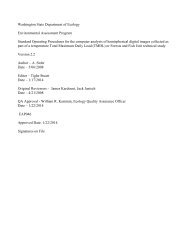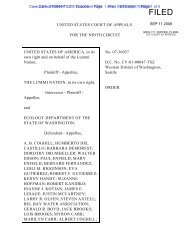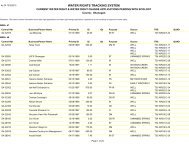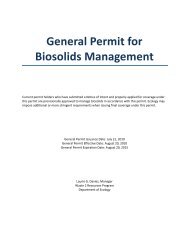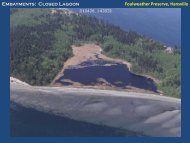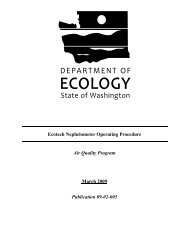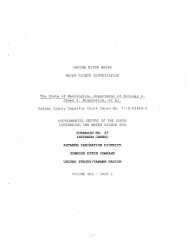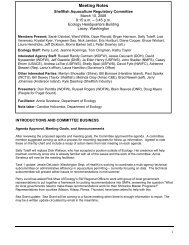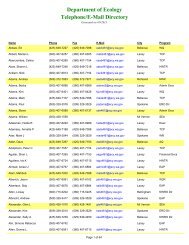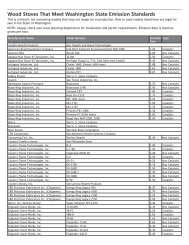WRIA 62 WMP 032305 - Washington State Department of Ecology
WRIA 62 WMP 032305 - Washington State Department of Ecology
WRIA 62 WMP 032305 - Washington State Department of Ecology
You also want an ePaper? Increase the reach of your titles
YUMPU automatically turns print PDFs into web optimized ePapers that Google loves.
March, 2005 -51- 023-1289-003.3040<br />
The concern with flooding in the Box Canyon project area is primarily in the low lying areas <strong>of</strong> the<br />
Calispell, Trimble and Cusick Creek valleys and includes the town <strong>of</strong> Cusick. In this area the creeks<br />
usually experience high spring flows in March through April associated with snow melt within <strong>WRIA</strong><br />
<strong>62</strong>. During these high spring creek flows it is important to pump the water from these creeks over the<br />
dikes into the Pend Oreille River as well as to allow the creeks to free flow through the dikes. The<br />
high flows in the Pend Oreille River mainstem usually occur in May and June and are associated with<br />
higher elevation snow melt in the Clark Fork watershed. If the lower lying spring melt in <strong>WRIA</strong> <strong>62</strong><br />
coincides with high spring flows in the Pend Oreille mainstem (when the creeks are unable to free<br />
flow into the Pend Oreille River mainstem through the dikes), flooding is more likely to occur in the<br />
Calispell, Trimble and Cusick valleys since water discharge from these creeks over the dikes is<br />
limited by the capacity <strong>of</strong> the pumps. Coordination between Diking Districts, the PUD and the<br />
ACOE at this time is necessary to help limit flooding as much as possible (ACOE, 2002).<br />
This flooding potential in <strong>WRIA</strong> <strong>62</strong> is exacerbated during those years when the elevation <strong>of</strong> Pend<br />
Oreille Lake is held high (above 2053 ft amsl) in the winter resulting in a reduction <strong>of</strong> storage<br />
capacity in the lake. Additional inflow to the lake must be passed on by Albeni Falls Dam to avoid<br />
flooding in the towns along the lakeshore, in particular Sandpoint. When Pend Oreille Lake is held<br />
lower during the winter (i.e. at elevations <strong>of</strong> 2051 to 2053 ft amsl), there is some storage capacity<br />
available in the lake and there is the potential that the Army Corps <strong>of</strong> Engineers (ACOE) can assist<br />
the PUD by releasing less than 43,000 cfs from Albeni Falls Dam for enough time to allow the creeks<br />
to free flow into the Pend Oreille mainstem along with pumping <strong>of</strong> water over the dikes. In addition,<br />
increasing the capacity <strong>of</strong> the pumps inside the dikes, may in some situations alleviate or reduce the<br />
impacts <strong>of</strong> flooding within the Calispell, Trimble and Cusick Valleys.<br />
4.1.4.1.2.2 Boundary Dam<br />
Boundary Dam (FERC project 2144) is located on river mile (RM) 17 within the northern portion <strong>of</strong><br />
<strong>WRIA</strong> <strong>62</strong>, about one mile south <strong>of</strong> the U.S. - Canadian border and is the last dam on the Pend Oreille<br />
River in <strong>WRIA</strong> <strong>62</strong>. Boundary Dam is owned by the City <strong>of</strong> Seattle and is operated by Seattle City<br />
Light under an original FERC license that was issued in 1961. This original license expires at the end<br />
<strong>of</strong> September 2011.<br />
Boundary Dam provides approximately 40% <strong>of</strong> Seattle's annual energy and is operated for optimum<br />
energy production and system reliability in the northwest, primarily considering power generation<br />
economics, peak load-following and providing operating reserves.<br />
Seattle's FERC license allows Boundary Dam to operate with a maximum drawdown <strong>of</strong> forty feet,<br />
from a normal full pool <strong>of</strong> 1990 ft amsl. Typically, the dam operates within a twenty-foot drawdown<br />
from a full pool <strong>of</strong> 1990 ft amsl. The Boundary Dam reservoir extends to Box Canyon Dam (located<br />
17.5 river miles upstream <strong>of</strong> Boundary Dam).<br />
Boundary Dam discharges approximately 52,000 cfs at full generation capability at full pool. At<br />
flows between 52,000 cfs and 160,000 cfs the incremental water is discharged via two radial-gated<br />
spillways located on each abutment. Incremental flow from 160,000 cfs to 395,000 cfs is passed via<br />
seven gated sluiceways.<br />
Due to natural river constrictions and the 17.5 mile distance between Boundary Dam and Box Canyon<br />
Dam, operations at Boundary Dam have limited, if any, impact on operations at Box Canyon Dam<br />
during times when flooding upstream <strong>of</strong> Box Canyon Dam is a concern. Boundary Dam is required<br />
to notify dams downstream <strong>of</strong> high flows, including Teck Cominco's Waneta Dam (when flows at<br />
<strong>WRIA</strong> <strong>62</strong> <strong>WMP</strong> <strong>032305</strong>



